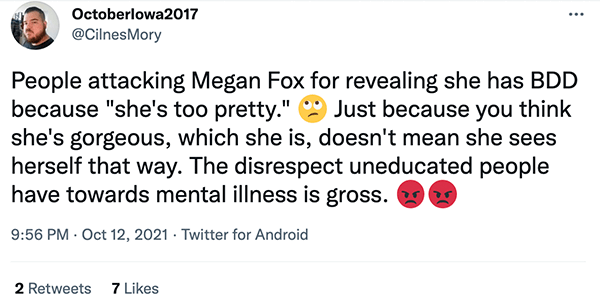BDD
Body dysmorphic disorder
Example
I can't believe Megan Fox suffers from BDD, she is so gorgeous

Related Slang
| ED | Eating disorder |
| OCD | Obsessive compulsive disorder |
| PTSD | Post-traumatic stress disorder |
| TW | Trigger warning |
| It me | I identify with that |
| Snapback culture | Pressure on new moms to snap back to their pre-pregnancy bodies |
| Relationship weight | Weight gained from a romantic relationship |
| Revenge body | A physically fit body after breaking up |
 Are you financially literate?
Are you financially literate?
BDD stands for "body dysmorphic disorder," which is when a person fixates on perceived flaws in their appearance even though they are minor or nonexistent. It is classified as a mental health disorder that can be debilitating and an obsession.
Individuals who suffer from BDD intensely focus on and magnify aspects of their body that they deem imperfect. It could be the size of their nose, the proximity of their eyes, the size of their rear, or the length of their legs.
When do people use BDD?
People typically use BDD in forums and on social media to refer to the disorder. They also use it in person since it's a lot quicker than saying the full name of the condition.
Who is affected by BDD?
Both men and women may be affected by BDD, but it often occurs in teenagers and young adults. Regardless of how "beautiful" a person is considered, they may still struggle with their own mental perception of themselves. As a result, they may attempt to hide their imperfections or go so far as having plastic surgery to fix their perceived flaws.
With the advent of social media, BDD has increased, and it is especially prevalent among those in the limelight, like celebrities. Some famous examples of people who have struggled with BDD include Michael Jackson, Sylvia Plath, Billie Eilish, and Andy Warhol.